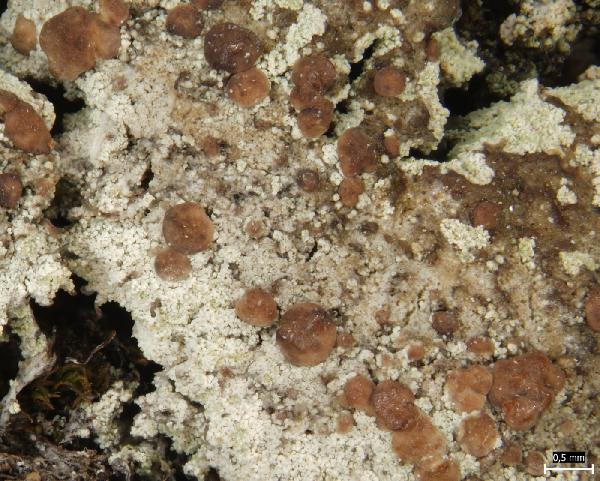Lecanora flavoleprosa Tønsberg
Sommerfeltia, 14: 161, 1992
Synonyms:
Distribution:
Description: Thallus crustose, episubstratic, subleprose when on plant debris, areolate-sorediate on bark or wood, forming up to 8 cm wide patches, without a distinct prothallus, the areoles sparse, more or less contiguous to confluent, greyish to pale yellow, rounded, strongly convex, up to 0.2 mm wide, soon completely dissolved into soredia. Soralia pale yellow-green, diffuse, confluent into a more or less continuous crust, the soredia loosely arranged, farinose to granulose, 30-65 μm in diam., with a distinct wall. Apothecia biatorine, up to 0.4 mm across, sparse to clustered, yellowish beige or greyish green to brown, blackish brown or almost black, sometimes with a dark aeruginose tinge, adnate to sessile, at first convex then flat, emarginate or with a non-raised, glossy brown margin. Proper exciple with brownish crystals dissolving in K, dirty olivaceous in upper part, pale brown to colourless in lower part; epithecium and upper part of hymenium aeruginose, K-, N+ violet, with an epipsamma of fine crystals dissolving in K; hymenium colourless in lower part, 40-50 μm high; paraphyses simple, slender, c. 1.5 μm wide, the apical cells hardly swollen; hypothecium colourless. Asci 8-spored, clavate, Lecanora-type. Ascospores 1-celled, hyaline, ellipsoid, sometimes slightly curved, 10-15 x 4-5 μm, thin-walled. Photobiont chlorococcoid, the cells up to 12 μm wide. Spot tests: K-, C+ yellow-orange, KC+ yellow-orange, P-. Chemistry: usnic acid, flavoleprosa-unknown, zeorin, traces of unidentified terpenoids. Note: a boreal-montane to arctic-alpine species found on bark and wood of coniferous and deciduous trees, and on humus and plant debris, or sometimes also stems and twigs of dwarf shrubs in open, mostly well-lit places of the subnival and alpine belts; known from Scandinavia, the Carpathians and a few stations in the Alps (Austria, Switzerland), to be looked for in the Italian Alps.
Growth form: Crustose
Substrata: bark, lignum, soil, terricolous mosses, and plant debris
Photobiont: green algae other than Trentepohlia
Reproductive strategy: mainly asexual, by soredia, or soredia-like structures (e.g. blastidia)

Predictive model
Growth form: Crustose
Substrata: bark, lignum, soil, terricolous mosses, and plant debris
Photobiont: green algae other than Trentepohlia
Reproductive strategy: mainly asexual, by soredia, or soredia-like structures (e.g. blastidia)

Predictive model
 INDEX FUNGORUM
INDEX FUNGORUM
 GBIF
GBIF


